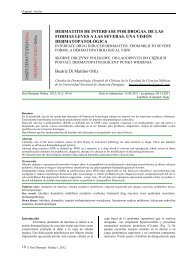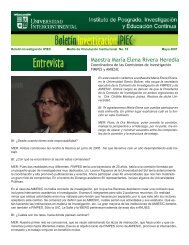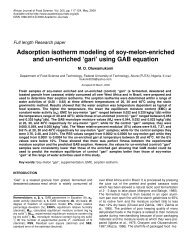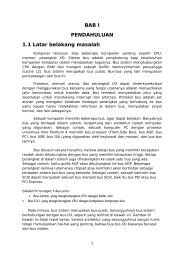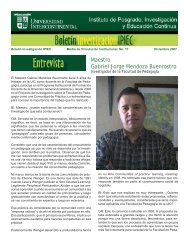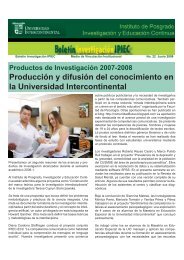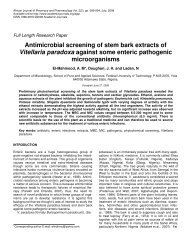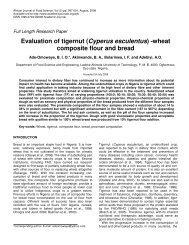Lacasses in the textile industry - Science Stage
Lacasses in the textile industry - Science Stage
Lacasses in the textile industry - Science Stage
Create successful ePaper yourself
Turn your PDF publications into a flip-book with our unique Google optimized e-Paper software.
120 Biotechnol. Mol. Biol. Rev.<br />
et al., 2005).<br />
2.2 Denim f<strong>in</strong>ish<strong>in</strong>g<br />
In <strong>the</strong> <strong>textile</strong> f<strong>in</strong>ish<strong>in</strong>g <strong>in</strong>dustry, enzymatic degradation of<br />
<strong>in</strong>digo could have a potential both <strong>in</strong> stone-wash process<br />
and for <strong>the</strong> treatment of dye<strong>in</strong>g effluents. Several steps<br />
are <strong>in</strong>volved <strong>in</strong> <strong>the</strong> manufacture of denim garments between<br />
dye<strong>in</strong>g and <strong>the</strong> f<strong>in</strong>al stone-wash<strong>in</strong>g where excessive<br />
amounts of <strong>in</strong>digo are removed from <strong>the</strong> fabrics and<br />
discharged with <strong>the</strong> wastewater. The traditional technology<br />
of produc<strong>in</strong>g a stone-washed look <strong>in</strong> denim fabric<br />
<strong>in</strong>volves <strong>the</strong> wash of <strong>the</strong> fabrics <strong>in</strong> <strong>the</strong> presence of<br />
pumice to generate <strong>the</strong> desired erosion of <strong>the</strong> fabrics.<br />
Subsequently, <strong>the</strong> fabrics are partially blea-ched by a<br />
treatment with sodium hypochlorite, followed by neutralisation<br />
and a r<strong>in</strong>s<strong>in</strong>g step all caus<strong>in</strong>g substantial environmental<br />
pollution (Pedersen and Schneider 1998).<br />
In 1996, Novozyme (Novo Nordisk, Denmark) launched<br />
a new <strong>in</strong>dustrial application of laccase enzyme <strong>in</strong> denim<br />
f<strong>in</strong>ish<strong>in</strong>g: DeniLite TM , <strong>the</strong> first <strong>in</strong>dustrial laccase and <strong>the</strong><br />
first bleach<strong>in</strong>g enzyme act<strong>in</strong>g with <strong>the</strong> help of a mediator<br />
molecule. In 1999, USA launched DeniLiteII TM based on a<br />
new type of laccase with higher activity than that of<br />
DeniliteI TM . Also, <strong>in</strong> 2001, <strong>the</strong> company Zytex (Zytex Pvt.<br />
Ltd., Mumbai, India) developed a formulation based on<br />
LMS capable of degrad<strong>in</strong>g <strong>in</strong>digo <strong>in</strong> a very specific way.<br />
The trade name of <strong>the</strong> product is Zylite.<br />
Campos et al. (2001) reported <strong>the</strong> degradation of <strong>in</strong>digo<br />
both <strong>in</strong> effluents and on fabrics us<strong>in</strong>g purified laccases<br />
from Trametes hirsuta and Sclerotium rolfsii <strong>in</strong> comb<strong>in</strong>ation<br />
with redox-mediators and reported that bleach<strong>in</strong>g<br />
of fabrics by <strong>the</strong> laccases correlated with <strong>the</strong> release of<br />
<strong>in</strong>digo degradation products. More recently, Pazarlogliu<br />
et al. (2005) showed that a phenol-<strong>in</strong>duced laccase from<br />
Trametes versicolor was an effective agent for stonewash<strong>in</strong>g<br />
effects of denim fabric without us<strong>in</strong>g a mediator.<br />
Moreover, <strong>the</strong>y found that T. versicolor laccase without a<br />
mediator was more effective than commercial laccase<br />
(obta<strong>in</strong>ed from recomb<strong>in</strong>ant Aspergillus niger, Novo<br />
Nordisk, Denmark) with a mediator.<br />
2.3 Cotton bleach<strong>in</strong>g<br />
The purpose of cotton bleach<strong>in</strong>g is to decolourise natural<br />
pigments and to confer a pure white appearance to <strong>the</strong><br />
fibres. Ma<strong>in</strong>ly flavonoids are responsible for <strong>the</strong> colour of<br />
cotton (Hed<strong>in</strong> et al., 1992; Ardon et al., 1996). The most<br />
common <strong>in</strong>dustrial bleach<strong>in</strong>g agent is hydrogen peroxide,<br />
which is usually applied at alkal<strong>in</strong>e pH and temperatures<br />
close to boil<strong>in</strong>g. However, radical reactions of bleach<strong>in</strong>g<br />
agents with <strong>the</strong> fibre can lead to a decrease <strong>in</strong> <strong>the</strong> degree<br />
of polymerisation and, thus, to severe damage. Fur<strong>the</strong>rmore,<br />
a huge amount of water is needed to remove<br />
hydrogen peroxide from fabrics, which can cause problems<br />
<strong>in</strong> dye<strong>in</strong>g. Therefore, replacement of hydrogen peroxide<br />
by an enzymatic bleach<strong>in</strong>g system would not only<br />
lead to better product quality due to less fibre damage but<br />
also to substantial sav<strong>in</strong>gs on wash<strong>in</strong>g water needed for<br />
<strong>the</strong> removal of hydrogen peroxide.<br />
Tzanov et al. (2003a) reported for <strong>the</strong> first time <strong>the</strong><br />
enhancement of <strong>the</strong> bleach<strong>in</strong>g effect achieved on cotton<br />
fabrics us<strong>in</strong>g laccases <strong>in</strong> low concentrations. In addition,<br />
<strong>the</strong> short time of <strong>the</strong> enzymatic pre-treatment sufficient to<br />
enhance fabric whiteness makes this bio-process suitable<br />
for cont<strong>in</strong>uous operations. Also, Pererira et al. (2005)<br />
showed that a laccase from a newly isolated stra<strong>in</strong> of T.<br />
hirsuta was responsible for whiteness improvement of<br />
cotton most likely due to oxidation of flavonoids. More<br />
recently, Basto et al. (2006) proposed a comb<strong>in</strong>ed<br />
ultrasound-laccase treatment for cotton bleach<strong>in</strong>g. They<br />
found that <strong>the</strong> supply of low ultrasound energy (7 W)<br />
enhanced <strong>the</strong> bleach<strong>in</strong>g efficiency of laccase on cotton<br />
fabrics.<br />
2.4 Rove scour<strong>in</strong>g<br />
Flax process<strong>in</strong>g <strong>in</strong>to yarn essentially still follows traditional<br />
methodologies. As an alternative to <strong>the</strong> chemical<br />
scour<strong>in</strong>g of rove, Ossola and Galante, (2004) studied <strong>the</strong><br />
effects of several enzymes under slightly alkal<strong>in</strong>e pH<br />
conditions. They found that <strong>the</strong> treatment with laccase<br />
plus mediator performed better than <strong>the</strong> chemical one.<br />
Also, Sharma et al. (2005) showed that laccase enzyme<br />
could be used for rov<strong>in</strong>g treatment to improve yarn<br />
regularity. The advantage of <strong>the</strong> use of laccase <strong>in</strong> rove<br />
scour<strong>in</strong>g is that <strong>the</strong> process is performed under mild<br />
reaction conditions result<strong>in</strong>g, thus, <strong>in</strong> an ecologicallyfriendly<br />
process.<br />
2.5 Wool dye<strong>in</strong>g<br />
Sh<strong>in</strong> et al. (2001) showed that laccase was able to colour<br />
wool fabric that was previously padded with hydroqu<strong>in</strong>one.<br />
More recently, Tzanov et al. (2003b) and Zille<br />
(2005) also proved <strong>the</strong> ability of laccases for wool dye<strong>in</strong>g.<br />
They used a dye bath prepared with a dye precursor (2,5-<br />
diam<strong>in</strong>obenzenesulfonic acid), dye mo-difiers (catechol<br />
and resorc<strong>in</strong>ol) and laccase, without any dye<strong>in</strong>g auxiliaries.<br />
Additionally, <strong>the</strong> enzymatic reaction was carried out<br />
at pH and temperature values safe to <strong>the</strong> wool material.<br />
Fur<strong>the</strong>rmore, <strong>the</strong>y showed that by pro-long<strong>in</strong>g <strong>the</strong> contact<br />
time between wool, enzyme, precursor and modifier<br />
deeper colours were obta<strong>in</strong>ed <strong>in</strong> contrast to <strong>the</strong> conventional<br />
procees <strong>in</strong> which deeper colours are atta<strong>in</strong>ed by<br />
<strong>in</strong>creas<strong>in</strong>g <strong>the</strong> amount of dye. This makes wool dye<strong>in</strong>g<br />
with laccase an economically attractive alternative to <strong>the</strong><br />
conventional process, which uses high amounts of water,<br />
auxiliaries, acid and energy. This laccase application is a<br />
promis<strong>in</strong>g technology esp-ecially for <strong>the</strong> coat<strong>in</strong>g of natural<br />
and syn<strong>the</strong>tic materials.<br />
2.6 Anti-shr<strong>in</strong>k treatment for wool<br />
A process conventionally used for wool shr<strong>in</strong>k-proof<strong>in</strong>g is<br />
chlor<strong>in</strong>ation. This process degrades <strong>the</strong> exo-cuticle of <strong>the</strong>



